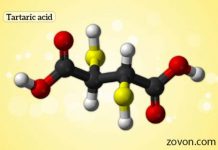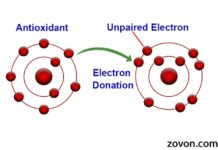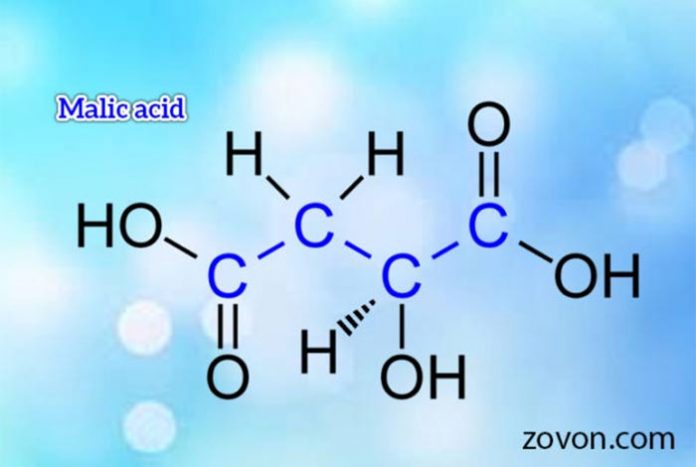
Malic acid is an organic compound found naturally in fruits. It is majorly derived from malum or apple, hence it is known as malic acid. Malic acid is also called as apple acid and belongs to AHA (Alpha Hydroxy Acid) family. It was first derived by Carl Wilhelm, from apple juice, in 1785. The sourness in fruits can be attributed to the presence of malic acid in them. It is synthesized in humans in one of the steps in Krebs cycle while the formation of ATP takes place which is a major energy booster.
Structure of Malic Acid:
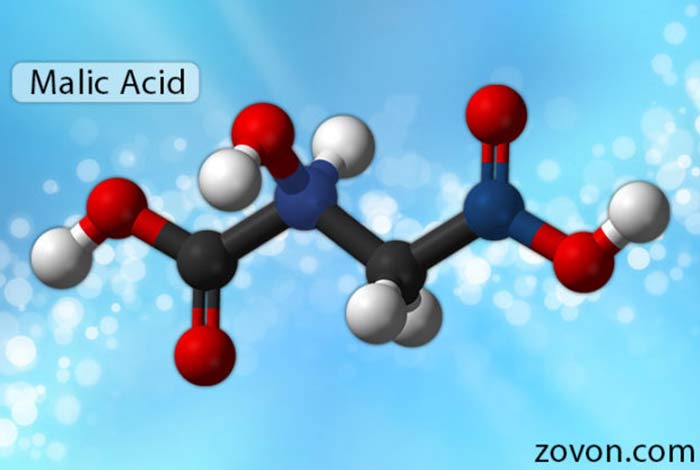
It is a dicarboxylic acid which means it has two carboxyl groups, containing four molecules of carbon, six molecules of hydrogen and five molecules of oxygen. Thus, the molecular formula of malic acid is C4H6O5. Malic acid is colorless as well as odorless. It is also known as hydroxybutanedioic acid.
Types:
There are two isomeric forms of Malic Acid (L and D) from which only L exists naturally. The salts formed out of malic acid are called malates.

Sources of Malic Acid:
- Fruits: It is naturally found in many fruits and vegetables. One of the finest sources of malic acid is watermelon which consists of 85-90% of acid. Other sources of Malic acid are Apples, peas, bananas, cherries, mango to name a few.

- Vegetables: Not only fruits but also vegetables have a high content of malic acid in them. It is found in vegetables like tomatoes, potatoes, broccoli, beans, carrot etc.
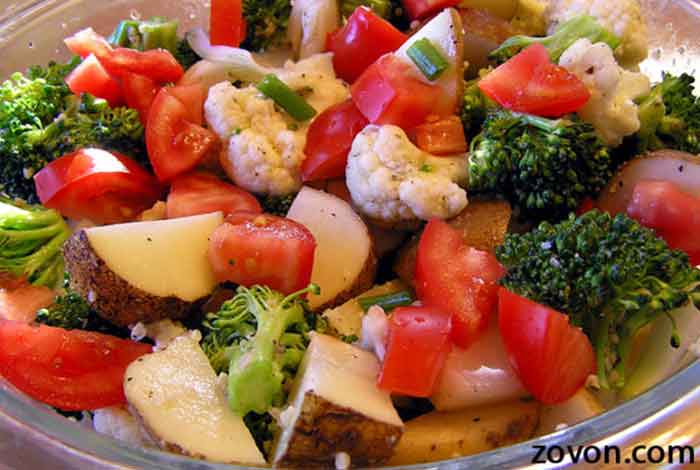
- Vinegar: Another source of malic acid is vinegar. Malic acid is also available in powder form as vitamin supplements.
Amazing Benefits of Malic Acid:
- Increases energy levels: Malic acid results in the formation of ATP which helps in producing energy.
- Relieves pain: Reduction in muscle pain and muscle soreness is noted by people who take malic acid either in its natural form or as supplements. Malic acid comes to rescue of patients with Fibromyalgia by reducing pain as early as within two days of taking malic acid. Malic acid is also known for binding toxic metals like lead and rendering them ineffective.
- Improves exercise tolerance: Malic acid helps in improving exercise tolerance by reducing the rates of getting exhausted quickly helping people to exercise for longer durations. It increases oxygen supply to muscle cells thereby improving stamina. It is also beneficial for the mind as it helps in a condition known as mind fog.
- Lowers blood pressure: One of the benefits of Malic acid is, it lowers blood pressure and can be used as a supplement for the same.
- Reduces chemical formation of germs: Malic acid reduces dangerous production of harmful chemicals in the mouth by producing right amounts of saliva. It has antiseptic properties.
- Medicines and personal care: Malic Acid is used as an ingredient in cough syrups, soaps, mouthwashes etc.
Applications of Malic Acid:
- Used in wine and beverages both carbonated and non-carbonated. In the process of winemaking, malic acid which tastes like tart is converted into lactic acid which is not so hard in taste.
- Used in candies to impart a taste of sourness. Since malic acid is highly soluble so it can be easily mixed with cooled candies. Thus, malic acid is used in flavoring or enhancing flavors.
- Malic acid increases flavors and juicy content in chewing gums.
- Malate is AHA that is alpha hydroxyl acid so it is used in the preparation of skin care cosmetics like anti-aging creams. It is used in chemical peels as its application burns the dead layer of the epidermis renewing and rejuvenating the skin.
- It is also used in hair products like shampoos and body lotions. Hair health can be substantially improved with malic acid as it acts upon bacteria in hair and dandruff.
- Used by patients suffering from fibromyalgia and chronic fatigue to remove pain and enhance energy levels. Some athletes take supplements of malic acid to improve their energy and subsequently improve their performance as well.
- Malic acid is used in the oil industry for transporting crude to the refineries.
Skin Care and Malic Acid:
- It has been noted that malic acid is a skin exfoliant, the application of which makes skin appear less patchy and smoother.
- The use of malic acid reduces fine lines and wrinkles, moisturizes skin by filling skin pores
- It is found in various skin care products in combination with other AHA like mandelic acid.
- Malic acid is known for hydrating the skin and increasing production of collagen in the skin.
- Malic acid is an antioxidant so it oxidizes free radicals thereby preventing premature skin aging.
- Malic acid breaks the bonds holding dead skin cells thereby removing lines and giving a brighter complexion to skin.
- Malic acid reduces skin pigmentation responsible for dark complexions and also helps in the treatment of acne.
- Malic acid balances internal pH levels. It helps in the shedding of outer skin layer removing impurities. Thus, it helps renewal of old skin.
Side Effects of Malic Acid:
- Malic acid derived from the natural sources does not have any notable side effects but when taken in additional supplements form in quantities higher than recommended, it may result in gastrointestinal problems like stomach bloating or experiencing cramps.
- It can also cause teeth erosion. Risk of cavities is also increased.
- Dry malic acid can be damaging to the eyes and can also cause difficulties in breathing.
- Malic acid, when applied to the skin, can cause itching and skin redness and prickling sensation.
- Side Effects of malic acid also include pain in the chest, constipation, allergies, swelling of throat, lips and skin.
FAQs: What people normally want to know about Malic Acid?
1. What are the uses of Malic Acid?
Malic Acid is useful for keeping the liver healthy. It is also used in tiredness and muscle pain. It is preferred by patients suffering from chronic fatigue and fibromyalgia.
2. What is the difference between malic acid and citric acid?
Malic acid is an acid that is sour in taste and naturally found in fruits and vegetables. Citric acid is present naturally in the juice of sour fruits and also made commercially from fermented sugar. Acidity of malic acid is 20% stronger than citric acid.
3. Which foods contain Malic Acid?
Apple, watermelon have a very high content of malic acid. Other fruits having a high concentration of malic acid are peaches, cherries, bananas, mangoes, tomatoes etc.
4. What is the difference between D-malic acid and L-Malic acid?
L-Malic acid is natural malic acid that is found naturally in fruits and vegetables. On the other hand, D-malic acid is synthetic malic acid that is synthesized in the laboratory.
5. How does Malic acid affect teeth?
Malic acid is highly harmful to teeth. It causes enamel erosion that breaks down the tooth enamel causing decomposition of teeth which cannot be reversed.


